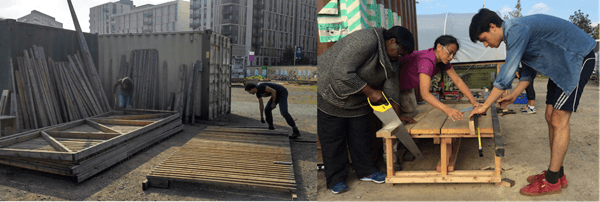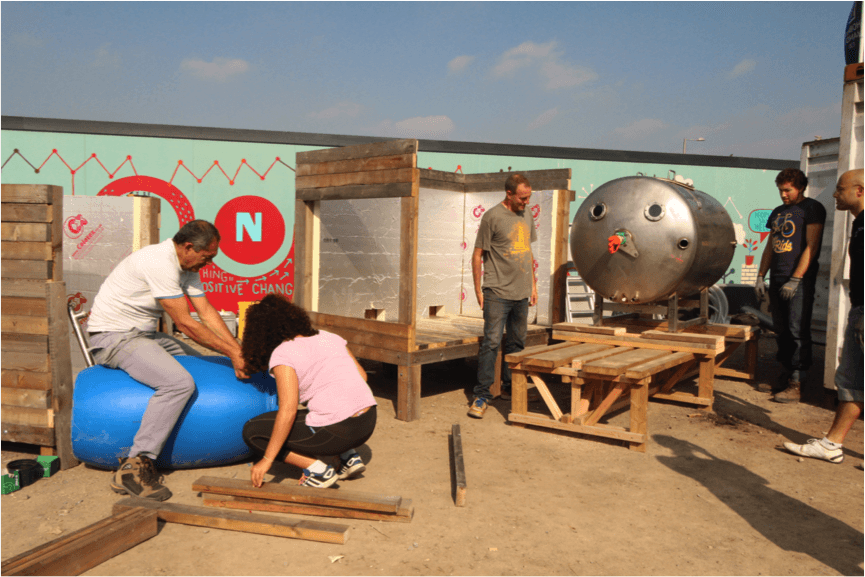Learn to build an anaerobic digester: ‘Build a Micro AD weekend’
By tjmscjo, on 15 October 2015
The third ‘Build a Micro AD weekend’ (3rd & 4th October)
Last weekend we had another sunny couple of days working on the project. Our engineer, Guy, delivered the digestor and prefeed tanks and the focus for the weekend was to finish the housing for the tanks, and to design the internal layout for all the systems that will be housed in the shipping container and make up the anaerobic digestor.

Image: inspecting the digestor. A number of windows have been added to the tank to allow for inspection even when the unit is up and running
There are a number separate closed systems to build for the unit:
a water system: The food waste is mashed up before being added, but also needs to be diluted with water to ensure it’s the right consistency for the digestor. We also need water to wash up. This means we need to have a rain harvesting system, water storage system and tanks.
a heating system; the digester and prefeed tanks need to be kept warm (approx. 35°C), to enable the food waste to break down and release the biogas.
a biogas system: the gas produced needs to be collected. It can be used in a boiler for the system’s own heating system, used a polytunnel on site to extend the growing season, or in a gas burning hob to create a mini kitchen / café.
an electricity system: We need electricity for the pumps, and to monitor the system. We’ll be using solar PV cells to generate the electricity and have some batteries to store it. [more detail on the electricity network?]
All of these systems have to be fitted in or on the shipping container.
Tasks for the weekend’s build:
A key focus was to make sure all the different systems can fit inside the shipper container. In the previous build weekend we had constructed the framed, wipe clean flooring that the tanks will stand on. We’d also built the housing for the tanks. This weekend we had to finish these off, insulate them, create the connections allowing the waste, water, gas, heat to flow between the different parts of the system and design in the access routes to feed, monitor and clean the system.
We worked in pairs or teams on a range of tasks, including:
- Salvaging timber (disassembling old fencing, removing staples)
- Insulating the digestor and pre feed tank
- Modifying the digestor tank
- Designing a separate macerating unit for the food waste
- Preparing the plumbing fittings for the prefeed tank
 Images: salvaging timber, sawing new lengths for tank frames.
Images: salvaging timber, sawing new lengths for tank frames.
The Group:
We had a mixed group of about 15 volunteers coming from all over London and with different interests. Some people were just looking for a fun activity to get involved with on a sunny day, others were specifically interested in learning about using food waste to generate energy, with plans to build their own units in the future. Others wanted to share their skills from engineering, product design, hacking and architecture to help build this ground-up demonstration of a small-scale circular economy.

Image: Marwa and Juan work on the plumbing for the blue prefeed tank. Behind, the others contemplate moving the digestor into it’s insulated housing.
The aim is for these weekends to be about getting to know people, getting to know the process, but also find opportunities to develop the project.
We are looking for local E20 volunteers who would be interested in being part of the management team with us to help run our circular economy. We will need to start a food waste collection service and fertiliser distribution network. We have a number of local cafes and growing groups interested in providing waste, and in taking fertiliser.
We have space to open a micro café on site and are looking for people who would be keen to pilot it. The digestor will generate gas for cooking on the site.
Next weekend (17th – 18th October)
Click here to read more about the Urban Wick project and upcoming events
Dr Charlotte Johnson is a Research Associate at the UCL Institute for Sustainable Resources
2 Responses to “Learn to build an anaerobic digester: ‘Build a Micro AD weekend’”
- 1
-
2
UCL_Energy wrote on 15 October 2015:
RT @UCL_ISR: New blog: ‘Learn how to build an anaerobic digester’, read the latest updates on the Urban Wick project: http://t.co/6os2jlU9g…
 Close
Close



New blog: ‘Learn how to build an anaerobic digester’, read the latest updates on the Urban Wick project: http://t.co/6os2jlU9gc @UCL_Energy